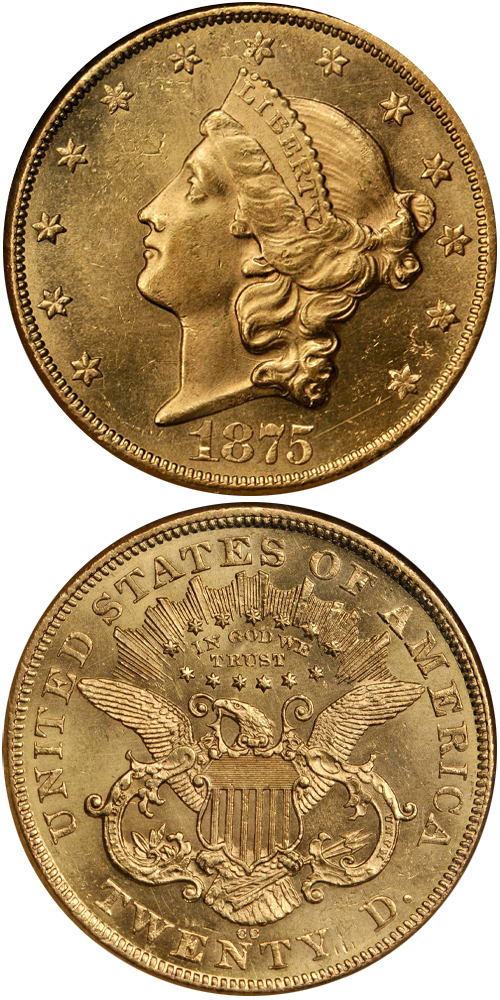1875-CC Liberty Head Double Eagle
Jeff Ambio: Doug Winter and Jim Halperin (Gold Coins of the Carson City Mint, 2001) list two different die marriages for the 1875-CC double eagle that employ two obverse and two reverse dies. Winter 1-A exhibits a large date logotype with the extreme left edge of the digit 1 over the left edge of a denticle. On the reverse, the CC mintmark is small, round and rather closely spaced. The first C is over the left serif of the right upright of the letter N in TWENTY, while the second C is over the space between the letters TY in the same word.
Rusty Goe: The Carson City Mint had just finished a record-setting year as 1875 began. The making of coins as mandated by the Specie Resumption Act, added to its increased workload. Even with the stepped-up demand for small denomination silver coins, gold pieces prevailed as the primary units of the nation's monetary system.
Over the course of the next five years (1875-1879) the Treasury Department planned to restore the nation to a more sound monetary system, by redeeming millions of dollars worth of "rag" currency, and supplying its citizens with all the hard money they wanted. The Comstock would provide much of the bullion needed to make the specie that would facilitate the redemption. The Carson Mint would process at least a portion of the Lode's output, as it would benefit greatly from the confluence of simultaneous events.
In June 1875, the Con. Virginia Mining Company deposited $1.5 million worth of bullion at the Carson Mint, the single largest transaction in that coin factory's history. Even though the Carson Mint's share of the Con. Virginia's bounty of bullion would amount to only a fraction of the whole, the mere fact that the Comstock giant had deposited it locally brought the institution some respectability.
The Carson City Mint produced 40,237 double eagles in the first half of 1875. The efforts of the second half of the year resulted in a total of 111,151 1875-CC double eagles.
Q. David Bowers: Regarding 1875-CC double eagles, Rusty Goe estimates 2,800 to 3,600 exist, of which 650 to 800 are Mint State. My estimates are slightly lower. Regarding Mint State coins, nearly all came back to the United States from overseas hoards examined since the 1950s. Prior to that, the population in collectors' hands was woefully small.
The trend started in a significant way in the 1950s and 1960s when James F. Kelly of Dayton (later Englewood), Ohio, imported these by the hundreds, most pieces being in grades from VF to EF. Then as now, there was an enthusiastic market for such coins, as the Carson City mintmark has always had a special numismatic cachet.
The example to the left was sold by Stack's Bowers Galleries in the August 2012 Battle Born Collection of Carson City Coinage, where it realized $64,625.






